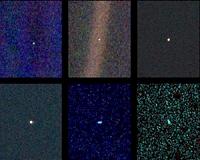 |
Baltimore, Ohio (UPI) Jan 17, 2011 NASA's twin Voyager spacecraft, approaching the edge of the solar system, are still operating and sending back data 33 years after their launch, scientists say. And they are still making news, as researchers announced last month Voyager 1 had outrun the solar wind, the first man-made object to reach the threshold of interstellar space, The Baltimore Sun reported Monday. It's a performance that impresses even Stamatios "Tom" Krimigis of the Johns Hopkins University's Applied Physics Lab, one of just two remaining principal investigators of the mission's original 11 still on the job 40 years after NASA approved the Voyager missions. "Needless to say, none of us expected it was going to be operating for so long," Krimigis, 72, said. "We were all praying to get to Neptune [in 1989]. But after that? Who thought we could be with this 33 years [after launch]?" Five experiments on each Voyager are still funded and seven of them are still delivering data. Problems do occur, but they can be fixed by radioed instructions -- instructions that take 12 hours to reach the unmanned craft. "I suspect it's going to outlast me," said Krimigis.
Share This Article With Planet Earth
Related Links Space Tourism, Space Transport and Space Exploration News
 Voyager Crosses Point Of Solar Stillness
Voyager Crosses Point Of Solar StillnessPasadena CA (JPL) Dec 20, 2010 The 33-year odyssey of NASA's Voyager 1 spacecraft has reached a distant point at the edge of our solar system where there is no outward motion of solar wind. Now hurtling toward interstellar space some 17.4 billion kilometers (10.8 billion miles) from the Sun, Voyager 1 has crossed into an area where the velocity of the hot ionized gas, or plasma, emanating directly outward from the Sun h ... read more |
|
| The content herein, unless otherwise known to be public domain, are Copyright 1995-2010 - SpaceDaily. AFP and UPI Wire Stories are copyright Agence France-Presse and United Press International. ESA Portal Reports are copyright European Space Agency. All NASA sourced material is public domain. Additional copyrights may apply in whole or part to other bona fide parties. Advertising does not imply endorsement,agreement or approval of any opinions, statements or information provided by SpaceDaily on any Web page published or hosted by SpaceDaily. Privacy Statement |